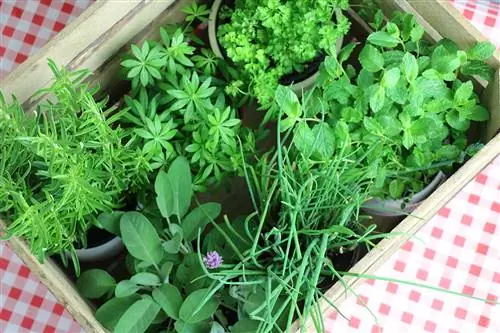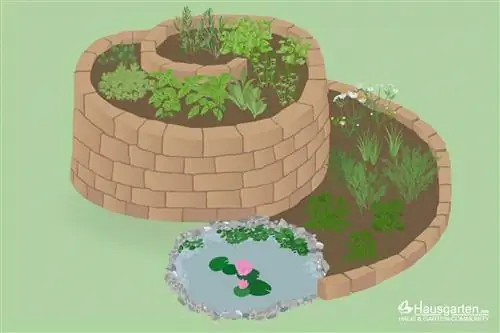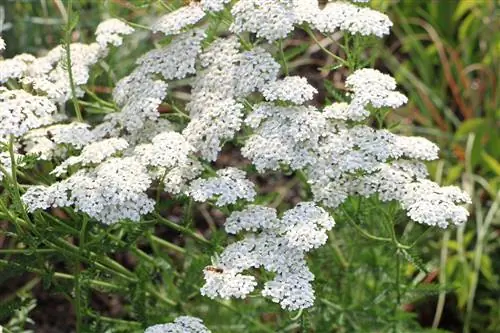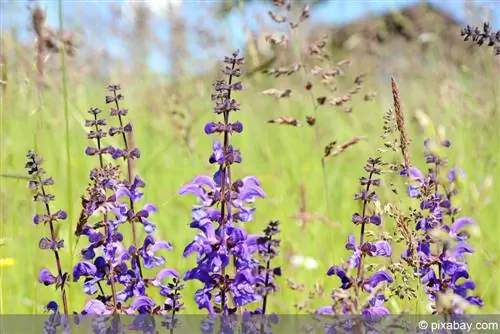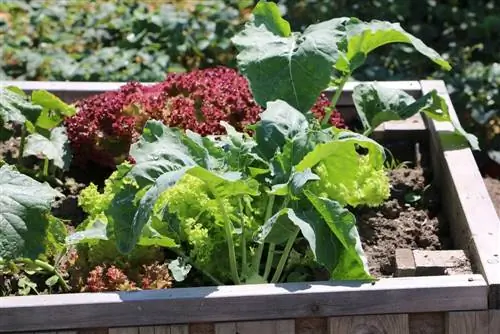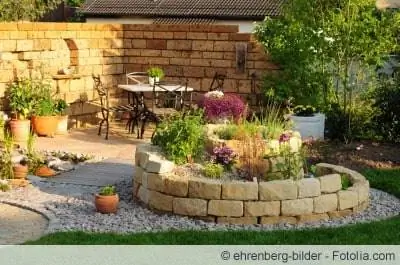- Author admin [email protected].
- Public 2023-12-17 03:39.
- Last modified 2025-01-24 12:45.
If you have a taste for herbs, the windowsill will soon be too narrow for you. A real herb bed is needed. But just as the different types of herbs do not all taste the same, their needs sometimes vary widely. A guide.
Herb selection
The selection of varieties is the crucial point when planning and creating a herb bed. Because the types of herbs grown, as beautiful as they are to look at, are primarily intended to be useful. So first put together a list of all the herbs you want to use or try. Of course, you can also choose one or another herb simply because it is decorative. Get an overview of location and care requirements.
Location search
The second step is to check whether your own garden offers a suitable location for the bed. Strongly scented herb species in particular need a lot of sun and warmth. The sunnier they are, the more essential oils they will produce. At the same time, they require rather dry and nutrient-poor soil that is not prone to waterlogging. These include basil, savory, lavender, oregano, rosemary, sage and thyme. Wild garlic, dill, fennel, chamomile, chervil, lovage, mint, parsley, chives and lemon balm want a semi-shady place with humus-rich, nutrient-rich and slightly moist soil. A few herbs, such as watercress, like it particularly moist.
Optimal size
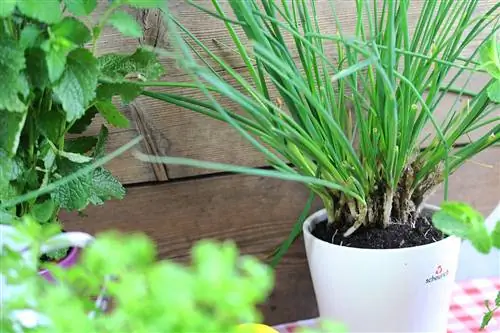
The bed should not be too large and should be accessible from all sides so that harvesting is easy at all times. For rectangular beds, sides of up to 1.2 m have proven to be optimal. For a well-stocked herb spiral, around three square meters is ideal. However, smaller spirals can also be built on just one square meter. Then the number of plants must be reduced or excessive growth must be prevented through pruning measures.
Simple garden bed
- low beds are the quickest and easiest to create
- with a border made of wood, wicker fence, brick or stone
- if applicable also possible without a border
Tip:
If you want to cultivate many types of herbs with different location requirements, it is difficult to please them all in a single bed. It might be worth planting two smaller herb beds in the ideal location.
Raised bed
- Raised bed enables back-friendly work
- Ready-made kits make assembly easier
- cheap DIY construction possible from leftover wood or pallets
- Herbs are harder for some pests to reach
Herbal spiral
- a herb spiral, also called a herb snail, looks decorative
- can be built from stones or bricks
- also winds upwards
- allows for different floor zones
- ideal for space-saving and optimal arrangement of herbs
- large stones store heat (ideal for Mediterranean plants)
Build herb bed
It's best to build the herb bed in the fall. Obtain appropriate instructions with all the detailed steps so that the construction is stable and lasts for many years. The side walls should extend at least 5 cm above the ground so that it is not washed away by irrigation water or rain. Layer natural stones carefully on top of each other so that they cannot slip at any time. If you implement your own constructions, pay attention to materials that can withstand moisture and are not coated with any toxic paints or similar.
Tip:
In a garden where there are many voles, a fine-mesh wire fence should be built horizontally into the ground at a sufficient depth and, if necessary, connected to the structure. How to protect the roots of herb plants.
Soil optimization
Tilling the soil should also be started in autumn so that the soil can settle by spring. First, the garden bed is loosened up to a depth of around 20 cm. Larger stones and weed roots should be removed in the same operation. Raised beds and herb spirals are also ideally filled with soil in autumn.
At least two weeks before planting. Depending on the herbs' needs, the soil is optimized with sand, compost and lime. Dry areas in the garden and raised beds need a drainage layer. A herbal spiral winding upwards is divided into the following areas from top to bottom:
- dry area: 50% each of sand and garden soil or herb soil
- temperate area: 30% each sand, compost and garden or herb soil, 10% lava granules
- moist area: 50% each of garden soil and compost
- Water area (optional): compost, if necessary with garden soil
Tip:
A herb bed should last for many years. It is therefore worth carrying out a soil analysis before planting. Soil improvement can be carried out precisely with the required minerals.
Planting a herb bed

Time
Start greening the herb bed in spring. You can use seeds, home-grown plants or larger commercially available plants. In the latter case, the harvest can start earlier and is therefore more plentiful overall. The plants purchased should be strong and well-branched, with good roots and flawless foliage. Then you won't introduce any pests or diseases into the bed. Frost-sensitive annual herbs may only be planted or sown outside after mid-May. Please note the sowing conditions on the seed bag.
Rules for planting
- Place potted herbs in a water bath until the root ball is soaked
- dig up a sufficiently large planting hole
- Maintain planting depth
- for good soil contact, press the soil down well
- pour with a fine spray
Tip:
Before planting, you can spread a special weed fleece over the soil into which you cut plant openings. This means that hardly any weeds will grow later. But the fleece does not replace winter protection measures for frost-sensitive herb species.
Tips for arranging herbs
1. Types of herbs for dry areas in full sun
- Mountain savory (Satureja montana)
- Curry herb (Helichrysum italicum)
- Lavender thymial (Thymus thracicus)
- Marjoram (Origanum majorana)
- Oregano (Origanum vulgare)
- Rosemary (Rosmarinus officinalis)
- Sage (Salvia)
- Thyme (Thymus vulgaris)
2. Types of herbs for temperate areas/partial shade
- Basil (Ocimum basilicum)
- Tarragon (Artemisia dracunculus)
- Spice fennel (Foeniculum vulgare)
- Small meadow button (Sanguisorba minor)
- Coriander (Coriandrum sativum)
- Lemon balm (Melissa officinalis)
- Parsley (Petroselinum crispum)
- Pimpinelle (Sanguisorba minor)
- Cut garlic (Allium tuberosum)
- Chives (Allium schoenoprasum)
- Hyssop (Hyssopus officinalis)
3. Types of herbs for damp areas
- Wild garlic (Allium ursinum)
- Borage (Borago officinalis)
- Dill (Anethum graveolens)
- Garden calamint (Calamintha grandiflora)
- Nasturtium (Tropaeolum majus)
- Chervil (Anthriscus cerefolium)
- Sorrel (Rumex acetosa)
4. Types of herbs for the water zone
- Bachbunge (Veronica beccabunga)
- Watercress (Nasturtium officinale)
- Calmus (Acorus gramineus)
- Sedanina (Apium nodiflorum)
- Watermint (Mentha aquatica)
- Waternut (Trapa natans)
5. Do not put these herbs in the herb bed
It is better to plant herb species that grow heavily or release inhibitory substances from their roots outside the herb bed. These include, among others, these species:
- Comfrey (Symphytum)
- Spice laurel (Laurus nobilis)
- Turmeric (Curcuma longa)
- Lavender (Lavandula officinalis)
- lovage, maggi herb (Levisticum officinale)
- Wormwood (Artemisia absinthium)
- Hyssop, vinegar herb (Hyssopus officinalis)
- Lemongrass (Cymbopogon citratus)
Lavender likes to take a place under a rose bush. Wormwood can be planted near currants because it keeps diseases away from them.
6. Do not mix annual and perennial plants
Make sure that you do not unnecessarily mix perennial and annual herb plants when arranging them. The annual soil work that is necessary for annual plants is disruptive for the other herbs.

7. Pay attention to good neighbors
Some types of herbs have very similar requirements in terms of location and care, while others form a good symbiosis against pests or promote each other's growth. When arranging, plan these good neighborhoods for a he althy, bountiful harvest:
- Mediterranean herbs among each other
- Basil with oregano, parsley and rosemary
- Parsley with basil, dill, garden cress, chervil and chives
- Tarragon, lemon balm, sage, chives and thyme
- Oregano, sage and winter savory
8. Avoid unfavorable combinations
- Parsley: borage, tarragon, chervil, coriander, lavender and peppermint
- Basil: marjoram, dill, peppermint and lemon balm
- Camile and peppermint
- Coriander: fennel, chervil and chives
- Thyme: marjoram and peppermint
- Wormwood: lemon balm, fennel and caraway
9. Place intensively scented herbs at the edge of the bed
In a simple herb bed or raised bed, you should place intensely fragrant herbs such as thyme, mint and oregano at the edge of the bed. Your essential oils will repel pests.
10. Make sure there is enough planting distance
Consider the size potential and also the growth rate of an herb. If the bed is very small, it is better to reduce the selection of herbs and instead rely on narrow plantings. This prevents pests and diseases.
11. Plant marigolds in the bed
Find a sunny spot for the marigolds in the herb bed. It repels lice, harmful nematodes and other pests. Their flowers are also edible.

